This is the second part of a series of blog entries on a gift I got from Matt Heusser. Today, I’m heading for touring the product.
Well, I know scrabble. I played quite some times, but I don’t like it that much. Now, this seems to be an electronic version of it. I started to get down my thoughts in a mind map. I identified three different things I would be interested in before opening the package. I plan to use session-based test management to test this product over the few hours.

My initial mission was to seek knowledge about the product, and see if I need additional missions that I didn’t think of initially. Let’s see where the first pursuit leads me to.
What’s the product about?
I open the package. There does not seem to be any documentation included. Just a tiny black box, covered with a bit of dust from the cardboard box, which has the name of the product printed on it.
I open the black box, and find the documentation in the cover.
There are two instructions in there. One is for the rules of the game. It’s labeled “Rules for 1+ players Ages 8+”. This makes me wonder whether there was something about the amount of players indicated on the original cardboard box. I take a look, no it wasn’t. My sense for the similar products heuristics strikes me. Other games tell you on its box how many players can play with this. Considering I had bought this in a regular shop, and just knew the rules of Scrabble, the board game, I would have thought this is a 2+ players game, too. Just after unpacking I found out, I can actually play this alone. I suspect there could be a problem with potential customers who are unaware of this fact – just as I was.

I continue to look on the second piece of paper. It’s heading tells me to read this before playing – I wonder what would happen if I didn’t, and read on to find out.
It states that I should remove the plastic covers from the tiles, always put them in a single line, and finally there are troubleshooting steps. In the first part I notice that the paper states that recycling the plastic is optional. I may also put it in my regular trash. Considering the world’s ecological problems, I note that it should state to always recycle it which could make this world a bit of a better place to live in.
For the sake of the moment I largely ignore the troubleshooting guidelines, besides the fact that each tile has some sort of battery in it. I put this one up in my mindmap on testing this product, as I am now interested in whether I am able to actually get replacement batteries for the tiles here in Europe. The backside of the manual tells me I need a particular type of battery, but I make this a separate charter. Another thing from the safety instruction indicate me, that there is a screw and a reset button. There is no screwdriver included (the manual also says that on that back), and how good is the reset button accessible are two more things I consider worthwhile to check.
Regarding the screwdriver, you may use a cross head or a straight head screwdriver. That’s also what the manual tells me. I think I’m done with this consideration. I keep the reset button as an additional charter for the future, as I want to play first.
Next, I wonder what would happen if I did not put the tiles in one line. In order to find out, I have to read more on the rules about the game, actually playing a round or two. I am now interested in how precisely I have to get the tiles in line. I’m going to find out.
From the manual I find out that there are actually three different games I can play. I put them in my mindmap to find out more about them later. Game 1 and 2 are for single player, game 3 is for three players. The manual states that the tiles will power-down after three minutes of inactivity automatically. I wonder whether this is a problem for me as a non-native speaking person. I also note that there is a four-tile variation of the game. I get that one down as well.
I continue with my self-set mission to see for the line-up boundaries. I remove the plastics from the tiles, and start playing around. There is a menu for picking game 1, 2, 3 that should appear when I get the pieces in line.

The tiles show some animation while not connected together. I start playing around with the tiles, but nothing really indicates a menu unless it get at least four of them in line.
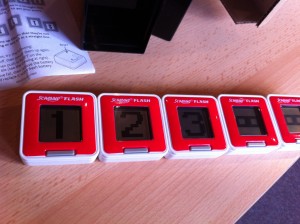
I start moving individual items out of line. Once the connection get lost, all five pieces start with the animation again.
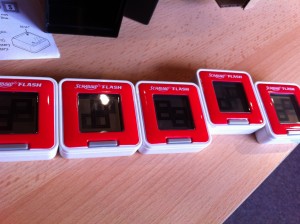
Another thing I’m interested in the connection is the distance between individual pieces. I can get them apart from each other and still maintain the connection. This seems to be robust enough for 8 year-olds to me, but I plan on some real action with some kids later.
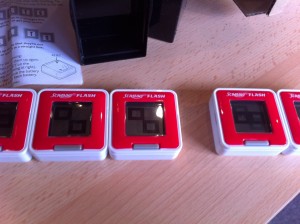
Accidentially I also notice another thing. When I put the piece with the “1” on it apart, the “2” gets a “1”, the “3” gets a “2”, and the second to last piece in the line gets a “3”, thereby indicating a four piece game to be started. I test around this for some time, to find out what happens. I notice that there is a short delay between the pieces finding each other, and getting lost again. I notice that the animation starts on the lost tile first then on the others. It’s about a split second delay, but I can still notice it.

Finally, I put the tiles up to extremes. I put them in line with as much offset as I can. Here is the final picture of the tiles still maintaining the connection.
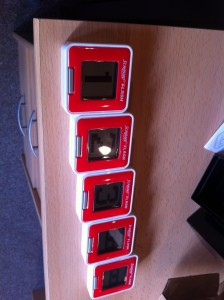
I take a closer look on the interface between the pieces. One thing I notice is that it’s a tiny hole in there. Seems to be an optic interface. I take a note to visit this topic under different lightning conditions.
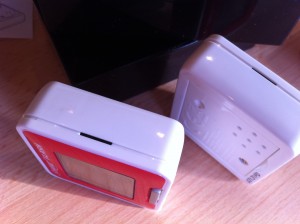
One final thing for this session is what happens when I turn one piece around. Since all pieces have two connectors, this could be possible. But it seems that the inventor thought about this as well. There seems to be an inbound and outbound connector, or something.
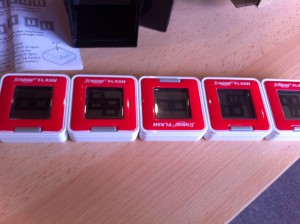
I end my session after this test.
Debriefing
After this first session with Scrabble Flash, I have now gained some knowledge about the product. There are three different game types with two different numbers of tiles. I plan to explore each of the games in a separate challenge. There are some subtle things I crossed over while testing. I have noted them in my mindmap. Here’s the updated one which also contains the priority of the sessions yet to come.
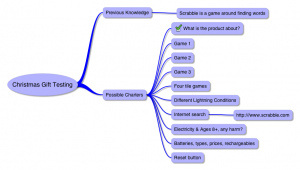
I also take notice of my thoughts about the product so far. I think it will be hard for me to come up with four- and five-letter words in English. This scares me a bit. Probably for the 8-year-old testing opportunity, I may ask my 11-year-old son who has had four years of English classes so far. I also noticed that the product seemed robust to me in this first session. This makes me curious about the first actual need of the troubleshooting instructions.
After all, testing games always is fun, so I look forward to my next mission, which will be around Game 1. To be continued in the next blog entry in this series.
2 thoughts on “A Christmas gift from a tester for a tester – Part Two”